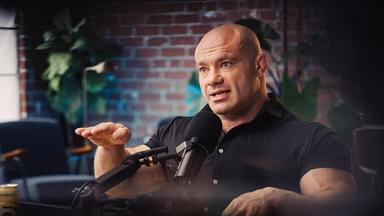Proper form and good technique are the basic requirements for muscle growth while working out. This helps avoid injuries of any sort, maximizes the significance of workouts, and helps achieve proper results. Speaking of technique while training, exercise scientist and co-founder of Renaissance Periodization, Dr. Mike Israetel, discusses the “importance of good technique.”
In Chris Williamson’s recent podcast, Exercise Scientist’s Masterclass on Building Muscle, Mike discusses various points on exercises. When the discussion on the importance of good technique for muscle growth came up, he had quite a few insights to share with some pointers.
Before getting into the details, Mike Israetel mentions how good technique has a huge variety of expressions. In the podcast, he states that when we look at a person doing a particular exercise, we cannot be sure whether that is a wrong technique. It could probably be good for them and the context.
However, there are a couple of generalities that apply to almost everyone and all exercises. Therefore, the best way to know if your technique is good is by checking the following factors: focus on targeting a specific muscle, stability, control, and full range of motion.
Focus on targeting a specific muscle or muscles
The first good technique Israetel shares is how one needs to focus on targeting a specific muscle. You must follow this, and by sheer biomechanics, you know if you’re doing this motion right or wrong. Mike further shares an example of what happens when one trains a muscle but often does it wrong.
He says most fitness freaks, when working out their quads, do a sumo stance, which is sitting back really far. Here, what happens is that you’re getting a very small degree of knee flexion. However, Mike says there are even better techniques to train your quads.
The better technique would be to expose the quadriceps muscles while targeting them. Which means we give them a high degree range of motion. Mike suggests that, when you squat down, your knees should go over your toes and go nice and deep when bending. This technique biomechanically helps train your quads in a better manner.
He also gave another example: when people train delts, they do alternating lifts with the fist pointed up. This routine hits the front delts, but it won’t possibly hit the side delts. If you want to gain big side delts, you need to change your technique.
“If you want big lats you’re going to do pull-ups or rows because it’s the sheer mechanics.”
Stability
The next way to check if your technique is correct is stability. A movement or an exercise should have a considerable degree of stability. Therefore, if you’re unstable and you’re doing upright rows, you keep coming up on your toes, and you’re wiggling around, then what happens is that it reduces your force production.
Hence, a good technique means being stable, because your body will dial down how much force your muscles can deploy. For example, if you stand on a vibrating plate or a balance beam, your muscle force comes into play.
He further shares a real-life experience with training by taking his host of the podcast as an example. If the two, Chris and Mike, are training together and start doing an incline dumbbell press, the shorter person will notice their feet are hanging off or kind of dangling.
However, the taller person would be able to put his feet down and stay steady on the ground. This helps the person gain stability while training, as you can complete more reps and will be able to do more weights with incline dumbbells. Hence, “stability is a technique universal.”
Furthermore, the host, Chris, mentions Tai Chi and how people ground themselves on the floor. However, he feels there’s no Tai Chi that’s happening, but it is our body responding to being more stable. To this, the professor Mike Israetel responds:
“I believe Tai Chi is entirely a myth also like all pretend things.”
Control
According to Dr. Israetel, control in general is eccentric, as most people can’t help but control the concentric. This is because it pushes back, and you can only move a concentric so quickly, especially with heavier weights. Particularly when you’re close to failure, someone cannot spastically do the concentric as they’re pushing against it.
He shares an example by stating that if you are trying to run your car up a high hill, it’s going to seem like you’re controlling it, but it’s just pushing back; that’s auto control. However, on the central control, which is the way down, people just let it drop, which isn’t terrible but does marginally increase your chance of injury.
However, what it does take for every muscle growth that promotes movement is eccentric. Eccentric requires less nervous system stimulus to do the same amount of physical. This means its inherent stimulus-to-fatigue ratio might be higher because it’s probably a little bit more stimulative than the concentric as a phase by itself but requires less nervous system fatigue.
“Over the weeks of controlling your centric, you may get more out of your muscles with less payment on the nervous system fatigue side.”
Full range of motion
Dr. Mike Israetel, during the podcast, says that full-range motion is a good technique as different parts of it are more or less hypertrophic. He then explains the importance of full-range motion on the cable flies. If one does a cable fly and stops mid-way, that won’t be good. He suggests that the trainee go ultra-deep while doing a cable fly and aim for a super-big stretch.
Though it is not clear as to why a stretch stimulates hypertrophy, multiple studies also suggest the same with candidate mechanisms being conducted. However, Mike states that, better than candidate mechanisms, they have conducted control trials where the only difference between groups is that one group goes nice and deep while the other does not.
“A lot of studies show that the deep stretch just causes more growth. Now it’s 5 to 10 percent more growth, so you can do top-end partials and get plenty of muscle growth.”
Therefore, if everyone goes in for that really deep stretch, that’s a big part of really good technique while working out. Hence, Mike suggests that to improve muscle growth, these are the best techniques to follow while training.





